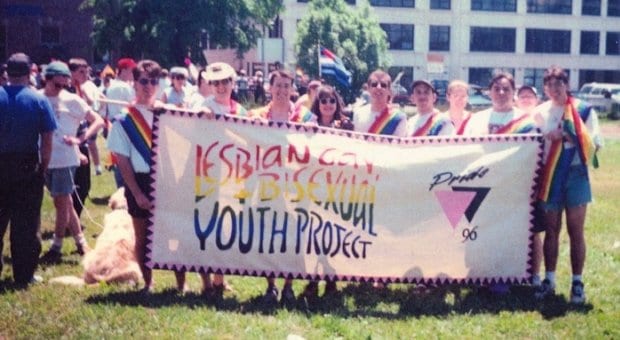
The Youth Project group leads the 1996 Pride parade as the parade marshals. Credit: Courtesy of Youth Project

Max and Hayley at Pride Week 2013. Credit: Courtesy of Youth Project
When Leighann Wichman attended the inaugural meeting of Halifax’s Lesbian, Gay and Bisexual Youth Project in 1993 with two university friends, they were only out to each another.
“It was the first time, even for the three of us, to go somewhere and meet other people who were also gay,” she says.
Twenty years later, the Youth Project (as it is now called) has broken that sense of isolation for hundreds of LGBT teens and young adults. Its members consider it a second home, a safe space of friendship, support, acceptance and celebration.
In reflecting on the Youth Project’s 20th anniversary this year, Wichman, now the executive director of the organization, says, “I know how important it was in my own life 20 years ago, and I can see how over 20 years that impact has happened again and again and again.”
The Youth Project began as a Dalhousie University School of Social Work student’s placement project under Planned Parenthood Nova Scotia’s watch. Its members kept it going after the placement’s end, and in 2002 the Youth Project became its own organization.
Over the years of youth coming through its hot-pink door in downtown Halifax, the Youth Project has had to adjust to members’ changing needs and address evolving LGBT issues in Nova Scotia.
For one, its members are getting younger. Wichman remembers the group’s first meeting as being populated by 19- to 25-year-olds. Now, she says, 90 percent of members are younger than 19, with some middle school students.
Keeping in touch with its members’ needs and interests is where the youth board comes in. It gives members a powerful say in the organization’s programs and services and sets the Youth Project apart from other queer organizations in the province, none of which solely target those younger than 25.
Its youthful focus is evident in its jam-packed social calendar: from annual events like Pride Week, a prom and two summer camps to guest speakers, workshops, activity nights and evenings reserved simply for hanging out.
It was through a show for the Youth Project that Nolan Pike, a musician originally from Toronto, got acquainted with the organization. He was so taken by the group that when he moved to Halifax some years later, he applied for a job there.
“I think that whenever you work with queer youth it’s inspiring, I hope, in both directions,” says Pike, 31.
In his role as community educator, Pike travels around the province offering workshops to students and teachers. His work is integral to the Youth Project’s mandate to offer support across Nova Scotia — something the Halifax organization has struggled with at times, Pike says.
Above all else, though, it’s the Youth Project’s seminal work with gay-straight alliances (GSAs) that has expanded its reach to rural areas. In 1998, the Youth Project held its first GSA conference, attracting about 50 students from a dozen schools. Soon thereafter, the province’s first GSA popped up at Lower Sackville’s Millwood High School. The province now has more than 70 such clubs, whose members flock to the organization’s annual GSA conference. The Youth Project also provides help in establishing and running GSAs.
“I think it’s pretty clear that GSAs have made an absolutely enormous impact on the level of homophobia in the schools, on the degree to which students feel safe,” Pike says.
But in Nova Scotia, the location of high-profile cases of cyber-bullying, discrimination and hate crimes, there’s more work to be done.
In May 2011, Aaron Stevens, then a 16-year-old Youth Project member, sat on a provincial cyber-bullying task force to provide an LGBT lens. Stevens says he was pleased with the task force’s “holistic” approach to tackling cyber-bullying, noting promising recommendations like legislating that school administrators cannot deny GSAs on unreasonable grounds.
Wichman says the root causes of bullying — homophobia and transphobia among them — are still not being fully addressed. And while legislation that added gender identity and expression to the Nova Scotia Human Rights Act in 2012 is promising, she says institutions like schools have not fully caught up in implementing it.
The Youth Project’s strength is in filling these gaps, providing safe social spaces, programs and education where they are lacking elsewhere.
That’s what attracted Stevens, then 14 and feeling isolated, to the Youth Project in the first place. The staff’s energy is what made him stay. “It’s something unlike anywhere else on the planet,” he says.
Despite having moved to Ottawa to attend university, he can’t help but pop through that hot-pink door on his visits to Halifax. “The Youth Project will always have a special place in my heart,” he says.
While the Youth Project doesn’t have goals set out for its next 20 years, its staffers can agree on one thing, as Wichman says: “Obviously, in a perfect world, we wouldn’t have to exist.”

 Why you can trust Xtra
Why you can trust Xtra


